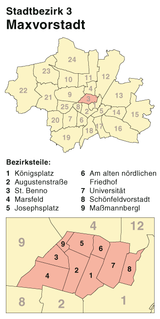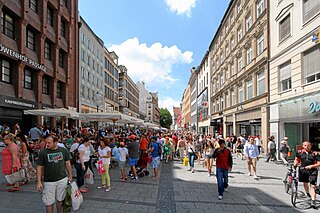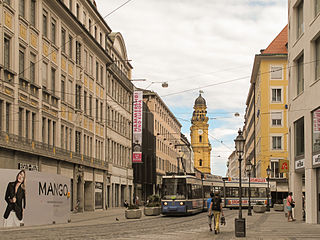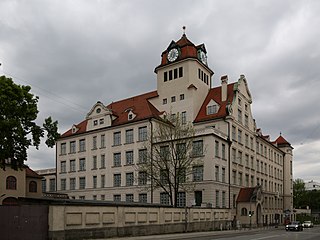
Stiglmaierplatz is a square in the Munich district of Maxvorstadt. It was named in 1845 after the artist Johann Baptist Stiglmaier and was previously the Kronprinzenplatz [1] and since 1826 it was known as the Ludwigplatz. [2]

Stiglmaierplatz is a square in the Munich district of Maxvorstadt. It was named in 1845 after the artist Johann Baptist Stiglmaier and was previously the Kronprinzenplatz [1] and since 1826 it was known as the Ludwigplatz. [2]

Today, Stiglmaierplatz is crossed in a northwestern direction by Dachauer Straße; shortly before which the multi-lane traffic of Seidlstraße flows into it at the level of the tram train station to the south and ends here. From the east, Brienner Straße ends at Stiglmaierplatz and merges into Nymphenburger Straße to the west. Schleißheimer Straße begins in the northeast. The square can be reached by public transport via subway lines 1 and 7 and tram lines 20, 21 and 22.

In the Middle Ages the square lay on a road leading from the Neuhauser Tor to Schleißheim and at the latest from the end of the 14th century served as a starting point for horse races on the so-called Rennweg, which ran where today's Schleißheimer Straße was built. [3] From 1448 the races were held annually during the Jakobidult on the route from the Neuhauser Tor in the direction of Feldmoching, which was also known as the Rennweg until 1878. [4] Not far north of today's Stiglmaierplatz, the country estate Wiesenfeld was located from the end of the 18th century. [5]

The Munich U-Bahn is an electric rail rapid transit network in Munich, Germany. The system began operation in 1971, and is operated by the municipally owned Münchner Verkehrsgesellschaft. The network is integrated into the Münchner Verkehrs- und Tarifverbund and interconnected with the Munich S-Bahn. The U-Bahn currently comprises eight lines, serving 96 stations, and encompassing 103.1 kilometres (64.1 mi) of routes.

München Hauptbahnhof is the main railway station in the city of Munich, Germany. It is one of the three stations with long-distance services in Munich, the others being München Ost and München-Pasing. München Hauptbahnhof sees about 450,000 passengers a day, which puts it on par with other large stations in Germany, such as Hamburg Hauptbahnhof and Frankfurt (Main) Hauptbahnhof. It is classified by Deutsche Bahn as a category 1 station, one of 21 in Germany and two in Munich, the other being München Ost. The mainline station is a terminal station with 32 platforms. The subterranean S-Bahn with 2 platforms and U-Bahn stations with 6 platforms are through stations.

The Maillingerstraße is a street in the Munich districts Maxvorstadt and Neuhausen. In the north-south direction, it connects Nymphenburger Straße with Marsstraße. It has been named after the Bavarian general and Minister of War Joseph Maximilian von Maillinger since 1886. Today Maillingerstraße is a minimal traffic secondary road.

The Munich tramway is the tramway network for the city of Munich in Germany. Today it is operated by the municipally owned Münchner Verkehrsgesellschaft and is known officially and colloquially as the Tram. Previous operators have included Société Anonyme des Tramways de Munich, the Münchner Trambahn-Aktiengesellschaft, the Städtische Straßenbahnen and the Straßenbahn München.

Maxvorstadt is a central borough of Munich, Bavaria, Germany and forms the Stadtbezirk (borough) 3 Maxvorstadt. Since 1992, this borough comprises the former boroughs 5, 6 and 7.

The Dachauer Straße is the longest street in Munich with a length of 11.2 km and it received its name since it is the connecting road to Dachau Palace. In the north of Munich, it is part of the Bundesstraße 304.

Schleißheimer Straße is the second longest street in Munich after Dachauer Straße with a length of 8.14 km. It starts in the city centre at Stiglmaierplatz, leads through five districts and ends at Goldschmiedplatz. It takes its name from the northern suburb of Oberschleißheim, where it originally ended.

Sendlinger Straße is an important shopping street in Munich's city center. It extends into the Munich old town in the south-east-northeast direction from the Sendlinger Tor in the west to the point where Fürstenfelder Straße and the Rindermarkt meet in the east. In July 2016, the conversion from a one-way street into a pedestrian zone was attempted.

The Stammstrecke 2 of the Munich U-Bahn is one of three main routes in the subway network of the Bavarian capital Munich. It runs from north to south, as well as east, and is currently operated by the underground U1 and U2 lines. Since 12 December 2011, the U7 line runs during high traffic times and since 15 December 2013 the U8 line assists on Saturdays. The U1 and U2 lines only run together on one route, in the central inner city area, before and after that, they are branched away from each other. The main line 2 has a total length of 33.8 kilometers and 38 underground stations. It runs exclusively in the city of Munich and completely in the tunnel.
Heinrich Theodor Höch was a German businessman.

The Georgenstraße is a street in Munich, Germany and runs in an east-west direction north of the city center. It separates the Maxvorstadt in the south from Schwabing in the north. It leads from Leopoldstraße in the east to Lothstraße in the west. In the street, especially at the beginning are several magnificent buildings, in the western direction are simple rental units. The Georgenstraße has little traffic significance and it is quiet despite its relative proximity to the city center; apartments, small shops, cafes and other small businesses are found there.

The Kaufingerstraße is one of the oldest streets in Munich and, together with the Neuhauser Straße, one of the most important shopping streets in Munich.

The Theatinerstraße is a street in Munich's old town. It connects the Odeonsplatz with the southern lying Marienhof and houses a number of classical buildings and several shops. The street received its name due to the adjoining Theatinerkirche; it used to be called Hintere Schwabinger Gasse.

Neuhauser Straße is part of the first and largest pedestrian zone in Munich's Old Town. Here, many retail shops and restaurants are to be found.

Boschetsrieder Straße is an inner city street in the Munich districts of Thalkirchen, Obersendling and Forstenried/Am Waldfriedhof, which runs west from Bundesstraße 11 on the Isar hillside to Kreuzhof, where it continues as the Fürstenrieder Straße.

Harthof is a district in the north of the Bavarian capital Munich. It is located in districts 11 Milbertshofen-Am Hart and 24 Feldmoching-Hasenbergl. Harthof consists of medium-sized housing estates and an estate of older council flats. The Harthofanger green area is located within.

The Petuelring is an approximately 2.2 km long road in the north of Munich and part of the Mittlerer Ring. It runs between Georg-Brauchle-Ring and Schenkendorfstraße.

Kurfürstenplatz is a square in the Munich district of Schwabing and is located about two and a half kilometres north of the city centre. It is the intersection of several streets and tram lines and was built in 1915 and named after the Elector Maximilian II. Emanuel, born in Munich in 1662.

Leonrodplatz is a square in the Munich district of Neuhausen. It was named in 1927 after the former Bavarian Minister of Justice Leopold von Leonrod.
| Wikimedia Commons has media related to Stiglmaierplatz . |